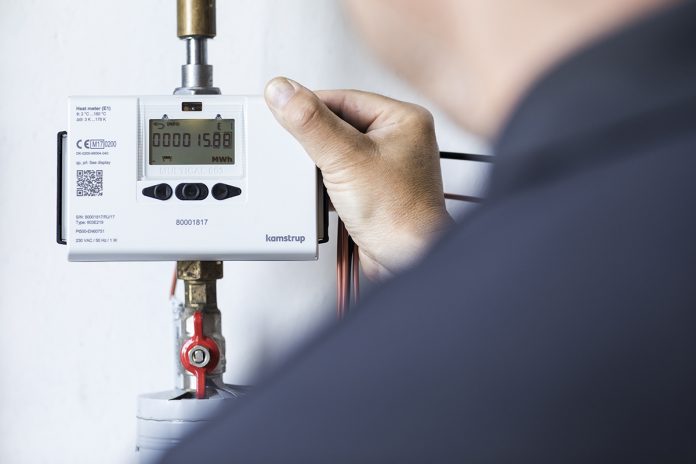Steen Schelle Jensen, Head of Product Management – Solutions, Kamstrup A/S, explains how Europe is making district heating smart
District heating provides the necessary flexibility to integrate, utilise and store waste heat and fluctuating energy from renewables, ultimately increasing the efficiency of the entire energy system. As a result, it holds the potential to fully decarbonise heating of buildings, which counts for 40% of the total European Union (EU) energy consumption.
However, unleashing this potential will require district heating to grow and become more sustainable and efficient while remaining both profitable, competitive and attractive to end-users – and that challenge is exactly as complicated as it sounds. Digitalisation is a key part of the solution because it gives district energy providers the transparency and overview they need to navigate in systems that are becoming more and more complex.
The digital (r)evolution
As district heating continues to evolve on its way towards 4th generation district heating, finding out tomorrow exactly what you should have done today is no longer good enough. Real-time decisions require real-time data. Essentially, digitalisation of district heating is about connecting the need for increased efficiency and optimisation with the opportunities made available by recent technological developments.
Frequent data from intelligent meters and sensors form the very foundation for the digital district energy provider while automated meter reading systems and advanced analytics enable the monitoring, analysis and planning necessary in the near future. And with the revised Energy Efficiency Directive (EED), the requirement to install only remotely read energy meters that can deliver frequent data is actually less than one year away.
The EED and beyond
Clear and timely information, as well as energy bills based on actual consumption, empower consumers to play an active part in reducing our energy needs. In 2018, the EED was, therefore, updated as part of the Clean Energy Package. One of the aims of this update was to clarify and strengthen the rules concerning metering and billing for heating and cooling. This was a natural step because energy efficiency in buildings is crucial to achieving the ambitious EU target of at least 32.5% energy savings by 2030.
According to the revised EED, meters installed after October 25th, 2020 must be remotely readable, and after January 1st, 2027, this requirement will apply to all existing energy meters. Whether meter reading is walk-by, drive-by or fixed network reading, data must be provided to the end-user at least 12 times per year. The adaptation of the EED is a clear sign that the EU is committed to developing a sustainable, competitive, secure and decarbonised energy system.
However, while its original driver was the empowerment of consumers, there are also clear benefits to be reaped by district energy providers ready to embrace the digital transformation that smart metering prompts. It is critical to bring focus to this potential, not least by ensuring that the legislative framework is available for district energy providers to utilise frequent meter data to attack the highly complex challenges facing the sector.
Making district heating smart
Once the meters are installed, the additional expense for a district energy provider to collect daily or even hourly data is minimal compared to the added value from adopting a more holistic digitalisation approach to its entire value chain.
First of all, smart metering provides the basis for district energy providers to make fact-based decisions related to their core tasks of producing and distributing district heating. These include optimising the production and forward temperature to run closer to the limit, detecting losses in the distribution network, as well as identifying improvement opportunities for building performance and consumer behaviour. This is all also crucial to achieving the right conditions and low temperatures to integrate more waste heat and renewable energy.
Secondly, frequent meter data – as opposed to theoretic models – enable district energy providers to monitor the performance of the underground pipes that make up the distribution network. Combined with innovative analytics solutions already available in the market, this allows better utilisation and renovation planning of existing assets so that they may avoid or defer some heavy investments in this area. Also, being able to compare the actual network load and capacity to its design criteria will reveal how well they match. In this way, district energy providers can both extend the current infrastructure’s lifetime and optimise dimensioning of new networks to avoid expensive oversizing.
Finally, smart metering enhances end-user involvement. District heating is often misconceived as old-fashioned, monopolistic and fossil-fuelled, but digitalisation can help district energy providers make it more attractive to consumers. This could include offering targeted services like billing based on flexibility, or taking responsibility for the heat installation, but also emphasising how it, for example, utilises waste heat from local supermarkets to heat homes in the community. In this way, end-users become part of the shared story of a sustainable energy system.
Green is the new black
Looking beyond the fact that digitalising district heating enables a sustainable energy future reveals that it is also simply good business. We have seen examples of district energy providers reducing network losses by as much as 12% and lowering temperatures by up to 10 degrees while still providing sufficient heating to consumers – all from optimisation based on smart meter data. Results like these mean that the return on investment period for smart metering solutions is seven to eight years, which is short compared to other investment horizons in the district energy sector.
Nevertheless, despite all of its potential, digitalisation in district heating will not happen automatically. It will take the joint efforts and high ambitions of technology suppliers, industry players, legislators and, most importantly, district energy providers themselves to learn how to best use cutting-edge technology to put into play the data available. This will pave the way for digital district energy providers with bottom lines that are as green as they are black, ultimately also benefitting consumers and society alike.
Please note: This is a commercial profile











